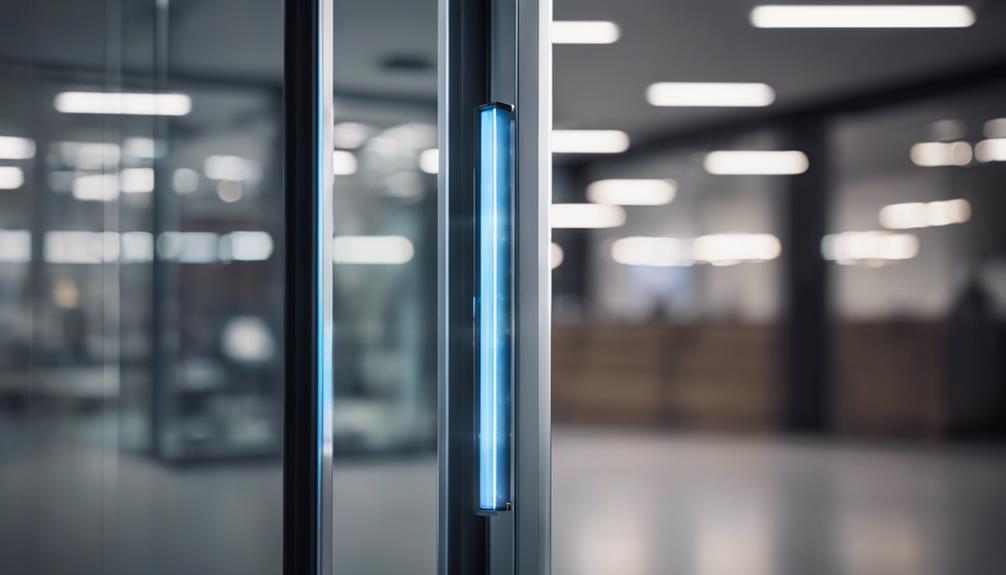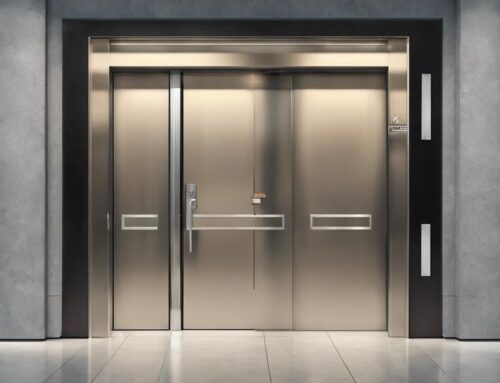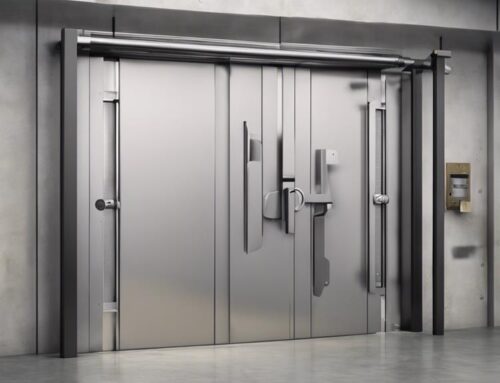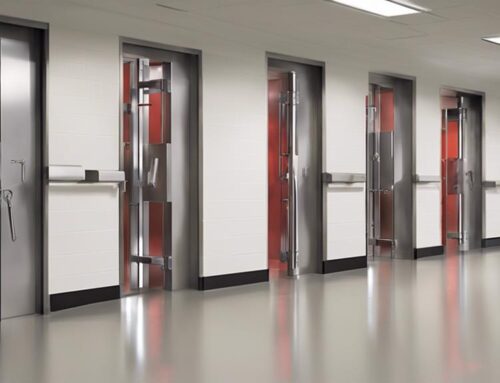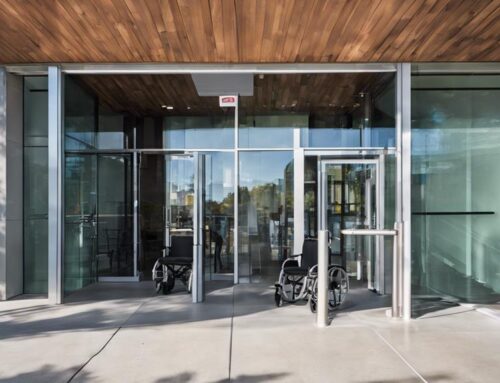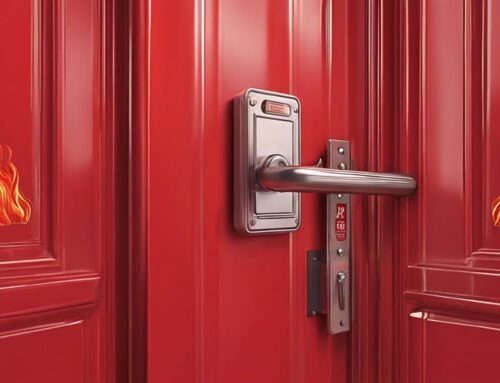Electronic panic bars are essential for modern security, integrating seamlessly with access control systems to enhance both safety and convenience. They utilize electric latch retraction technology for efficient remote operation and provide request-to-exit functionality for automated door opening. You'll find them in fail-safe and fail-secure configurations, ensuring compliance with stringent safety regulations. Top brands like Von Duprin, Sargent, and Adams Rite offer reliable, high-traffic solutions. Installation requires precise adherence to ADA mounting heights and robust power connections. Regular maintenance is vital for peak function. Explore further to understand the cost benefits and potential for future security enhancements.
Key Takeaways
- Integrates with access control systems, offering enhanced security and remote operation.
- Available in fail-safe and fail-secure configurations to meet different security needs.
- Features request-to-exit functionality for automatic and convenient door opening.
- Designed for silent operation, suitable for high-traffic commercial areas.
- Complies with ADA regulations, ensuring accessibility and safety compliance.
How Electronic Panic Bars Work
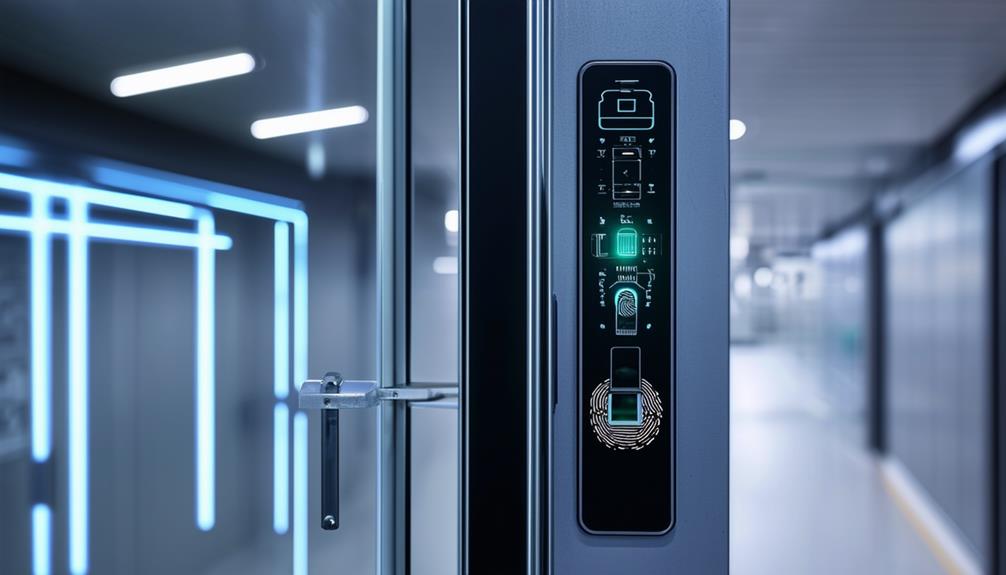
Leveraging electric latch retraction technology, electronic panic bars offer remote operation and swift egress during emergencies, eliminating the need for physical keys. These devices are intricately designed to integrate seamlessly with access control systems, enhancing security while guaranteeing compliance with fire and life safety egress requirements. You'll find that electronic panic bar technology includes sophisticated components such as electric latch retraction mechanisms that allow the door to open remotely or upon a signal from the access control system. For businesses looking to enhance their safety measures, expert consultation services can help in selecting the most suitable electronic panic bar solutions.
Understanding how these devices operate involves recognizing their request-to-exit functionality. This feature detects when someone is exiting and automatically triggers the door to open, streamlining the egress process. Electronic panic bars are available in both fail-safe and fail-secure configurations. In a fail-safe setup, the door opens during a power failure, guaranteeing safe evacuation. Conversely, a fail-secure configuration keeps the door locked during power outages, maintaining security.
Moreover, electronic panic bars are engineered for silent and efficient operation. This makes them ideal for high-traffic areas, where maintaining a quiet environment is vital. Their construction is robust, meeting rigorous safety standards to guarantee reliability and performance in critical situations.
Benefits of Electronic Panic Bars
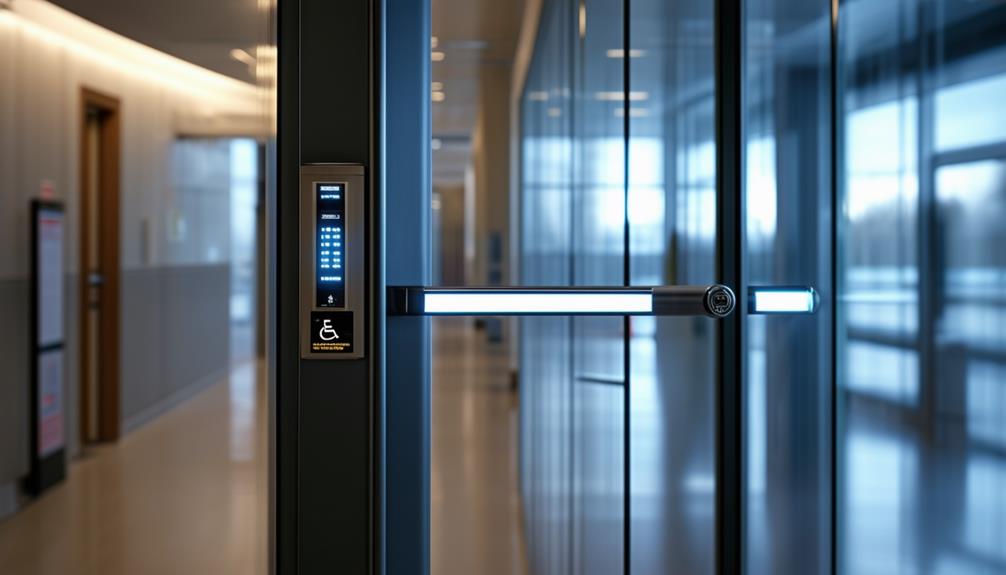
Electronic panic bars offer numerous advantages that make them indispensable in modern security systems. By integrating panic bars with electronic access control, you can notably enhance security at entry points. Remote opening capabilities allow for instant access control adjustments, guaranteeing that only authorized personnel can enter restricted areas. This integration also facilitates real-time monitoring, providing detailed logs of entry and exit activities. Additionally, they guarantee compliance with stringent safety regulations, providing peace of mind for facility managers.
Electric Latch Retraction (ELR) functionality guarantees quick and seamless exits, which is vital during emergencies. With ELR, you can maintain compliance with stringent safety regulations while providing a user-friendly exit solution. The Request-to-Exit (RTE) feature further improves accessibility, allowing users to exit effortlessly without the need to manually open the door.
Electronic panic bars also offer both fail-safe and fail-secure options. This flexibility guarantees that your system remains operational during power outages or emergencies, catering to varied security needs. The robust design of these devices supports high-traffic areas, making them ideal for commercial buildings. Furthermore, they guarantee compliance with fire and life safety egress requirements, offering peace of mind that your facility is both secure and safe.
Top Brands for Electronic Panic Bars
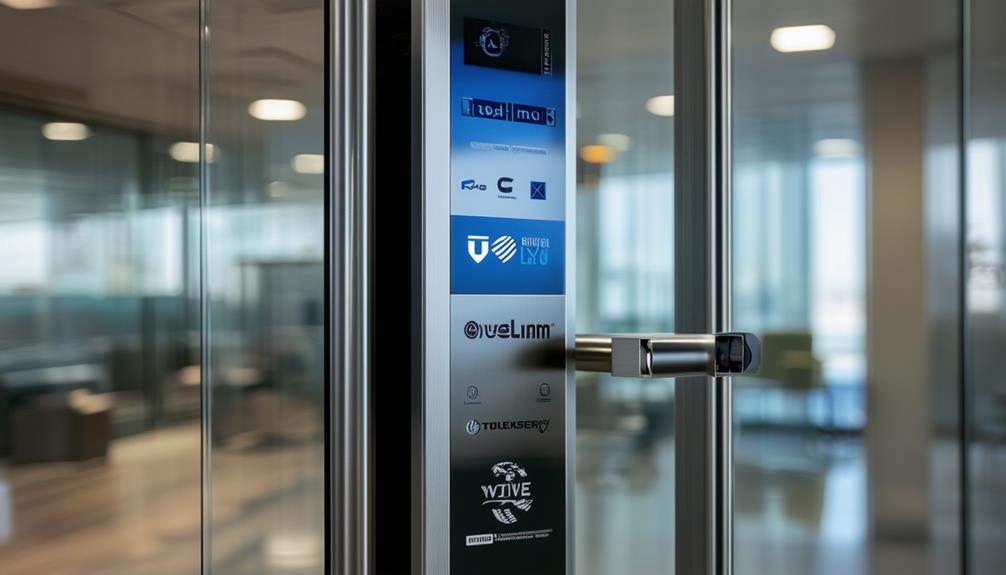
When considering the top brands for electronic panic bars, reliability and innovation are essential. You need electronic panic bar solutions that seamlessly integrate with your access control systems, guaranteeing both security and ease of egress. Industry leaders like Von Duprin, Sargent, and Adams Rite are renowned for their robust offerings in this space. Von Duprin specializes in Electric Latch Retraction (ELR) and Request to Exit (REX) functionalities, providing options for fail-safe or fail-secure mechanisms. Their products often come fire-rated, meeting stringent safety regulations while guaranteeing reliable operation in emergencies. Von Duprin's electronic panic bars are designed to handle high-traffic areas with ease, a vital factor for commercial applications. According to Choosing the Best Panic Bar Manufacturers, Von Duprin is highly regarded in the industry for its innovative and reliable solutions.
Sargent also offers exceptional electronic panic bar solutions, focusing on durability and versatility with various voltage configurations, such as 12V and 24V. Their panic bars are engineered for seamless integration with modern access control systems and provide reliable performance even in the most demanding environments.
Adams Rite stands out with its focus on high-traffic compatibility and fire-rated options. Their electronic panic bars are built to withstand the rigors of commercial use, guaranteeing both compliance and security.
Selecting the right brand guarantees you get dependable and innovative electronic panic bar solutions tailored to your specific needs.
Installation of Electronic Panic Bars
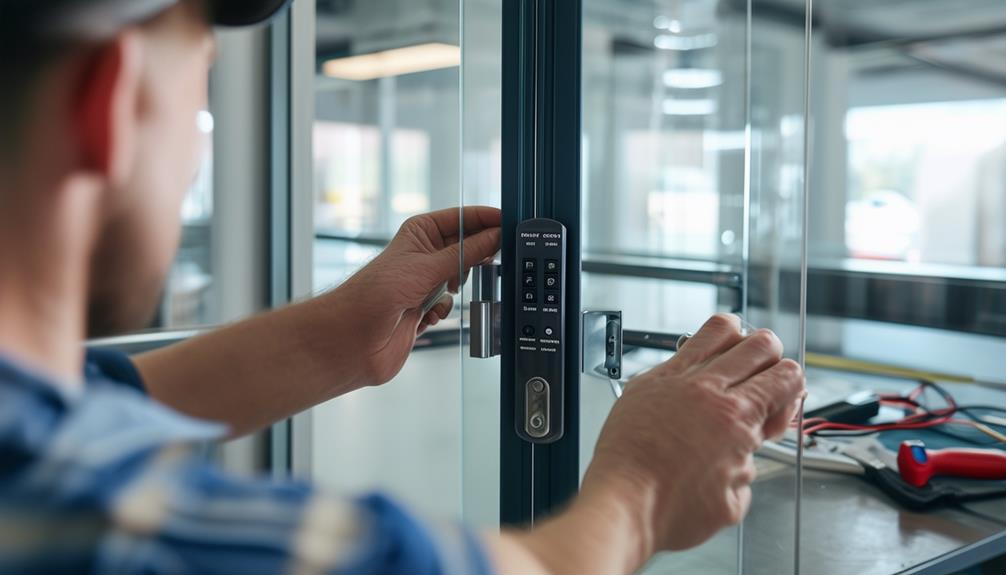
Installing electronic panic bars requires meticulous attention to detail to guarantee both functionality and compliance with safety standards. First, confirm the electronic panic bar is mounted at a height of 33-36 inches from the floor, adhering to ADA regulations. This placement guarantees accessibility for all users. When performing the electronic panic bar installation, it's essential to align the device accurately with the door frame. Misalignment can cause operational issues, so use proper mounting techniques and verify smooth operation without obstructions.
Next, connect the electronic components to a reliable power source, typically 12V or 24V, based on your system's specifications. Follow the provided wiring diagrams closely to avoid errors. Incorrect wiring can lead to malfunction or even void your warranty. In addition to wiring, regular maintenance verifies peak functionality over time, preventing potential issues that could compromise safety.
After securing the hardware, conduct thorough testing of the electric latch retraction and request-to-exit mechanisms. Make sure these features operate seamlessly. Regular testing and maintenance post-installation are essential to guarantee ongoing functionality and safety compliance.
Lastly, always refer to the manufacturer's installation instructions and troubleshooting tips. These guidelines are designed to assist you in achieving a successful and compliant electronic panic bar installation.
Troubleshooting Electronic Panic Bars
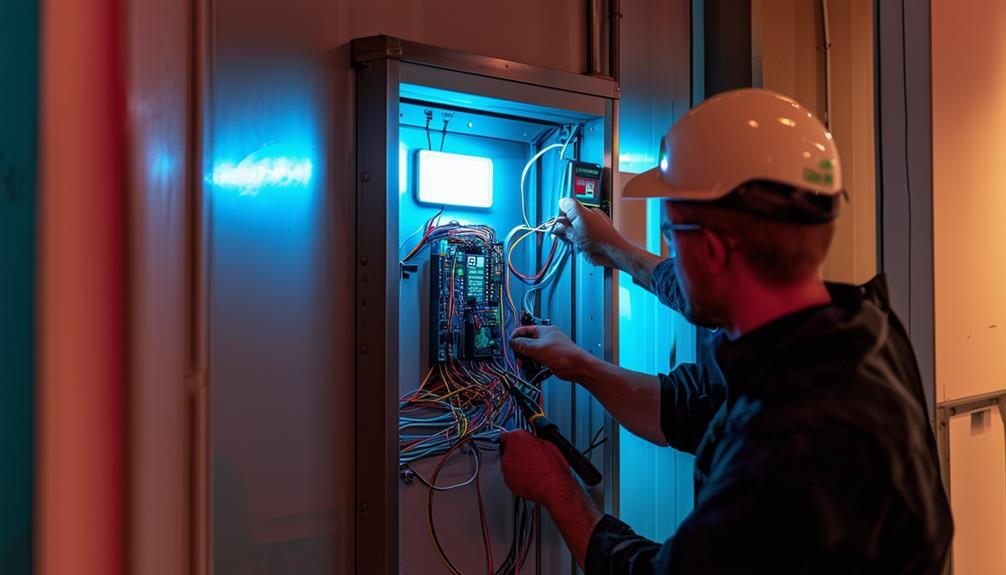
Power issues often top the list when troubleshooting electronic panic bars. First, verify the power supply is connected and functioning correctly. Any interruption in power can prevent the panic bar from operating. Inspect the wiring connections for damage or loose connections; these can greatly impact performance. It's also beneficial to perform routine maintenance as outlined by Low Rate Locksmith to catch any potential issues early on.
Next, check for mechanical jams or obstructions within the panic bar mechanism. Any hindrance can block movement or prevent retraction, compromising the functionality of the device. Clear any debris and verify all components move freely.
Another critical step in electronic panic bar troubleshooting is testing the request-to-exit functionality. This feature must recognize exit signals correctly and allow the door to release. If the system fails to respond, it might indicate a problem with the sensors or the connection to the access control system.
Regular maintenance and cleaning are paramount. High-traffic environments can cause wear and tear on the panic bar components. By keeping the mechanism clean and well-lubricated, you can prevent operational issues and extend the lifespan of your device.
Integrating with Security Systems
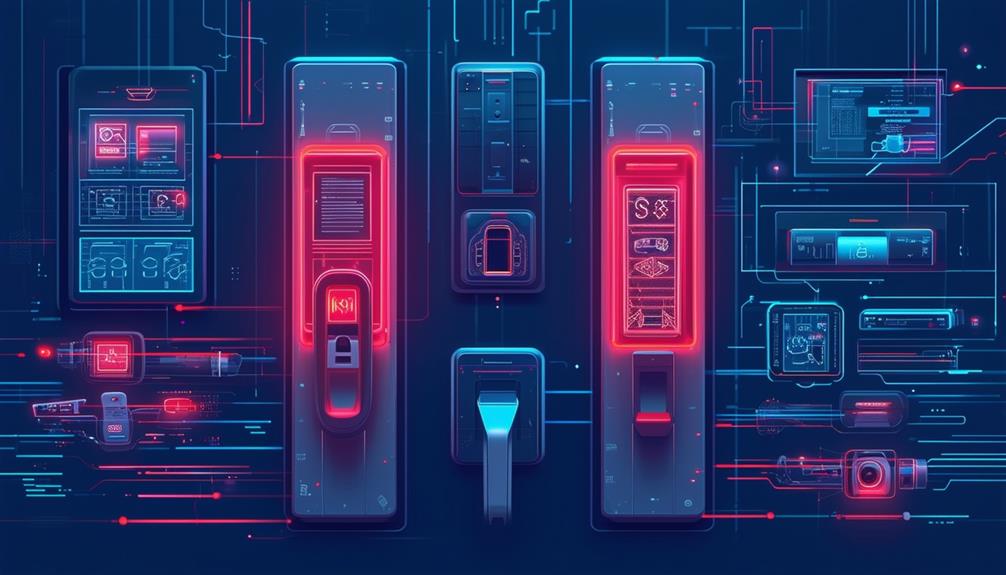
Electronic panic bars, integral to modern security infrastructures, seamlessly integrate with various access control systems to enhance security measures. These sophisticated devices offer multiple functionalities, guaranteeing both safety and convenience. With panic bars with electronic locks, you gain not just a physical barrier but also advanced access control features.
Key Integrations:
- Remote Access and Control: Electronic panic bars enable remote operations, allowing you to lock and open doors from a centralized system. This guarantees that only authorized personnel can access restricted areas.
- Electric Latch Retraction (ELR): ELR features facilitate rapid egress in emergencies, retracting the latch instantly while maintaining secure locking when idle. This dual functionality optimizes both safety and security.
- Request-to-Exit (REX) and Alarm Integration: The REX function permits controlled exits, guaranteeing compliance with safety protocols. Integration with alarm systems adds another layer of security, triggering alerts during unauthorized access or forced entries.
Additionally, well-maintained locks enhance overall safety and building security, further emphasizing the importance of regular maintenance. Furthermore, panic bars with electronic locks are compatible with both fail-safe and fail-secure mechanisms, providing reliable operation even during power outages or emergencies. This adaptability makes them an ideal choice for diverse security environments, guaranteeing continuous protection and operational efficiency.
Maintenance of Electronic Panic Bars
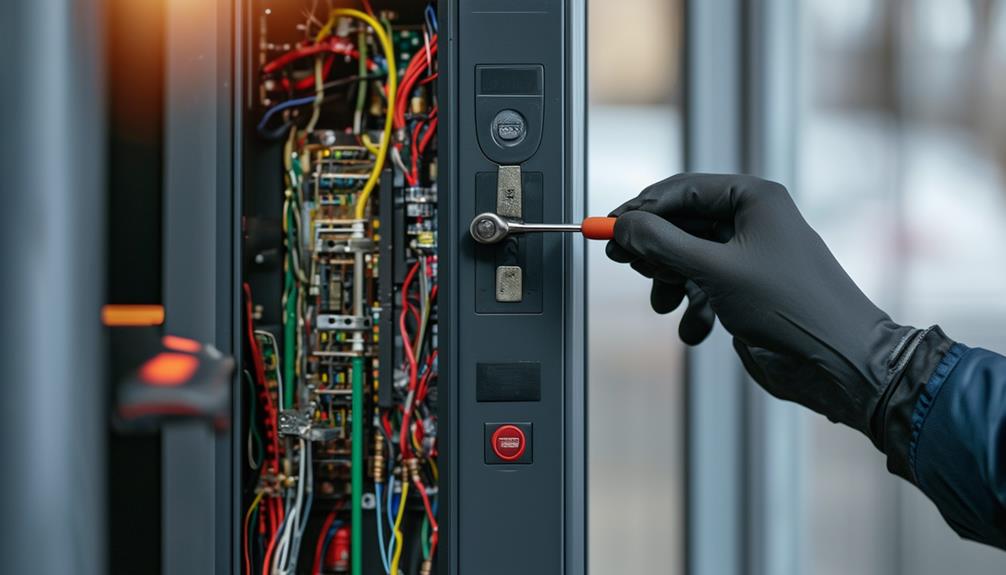
Guaranteeing the ideal performance of electronic panic bars hinges on meticulous maintenance practices, seamlessly aligning with their integration into advanced security systems. Regular panic bar electronic maintenance is essential to assure optimal functionality and adherence to safety regulations. Start by conducting periodic inspections of both electrical connections and mechanical components. This helps identify wear and tear before it becomes a serious issue. Additionally, make certain to keep a maintenance log to track all activities and identify patterns or recurring issues over time.
Test the electric latch retraction and request-to-exit features monthly. Their correct operation is imperative for reliable access during emergencies. Use a damp cloth to clean the panic bar and its surrounding hardware, preventing dust and debris buildup that could impair functionality.
Annual professional maintenance services are invaluable. Experts can spot potential issues early and ascertain all components are working as designed. Keep detailed records of all maintenance activities, including inspections and repairs. This documentation is essential for compliance with safety standards and can be critical during audits and inspections.
Cost Comparison: Electronic vs. Traditional
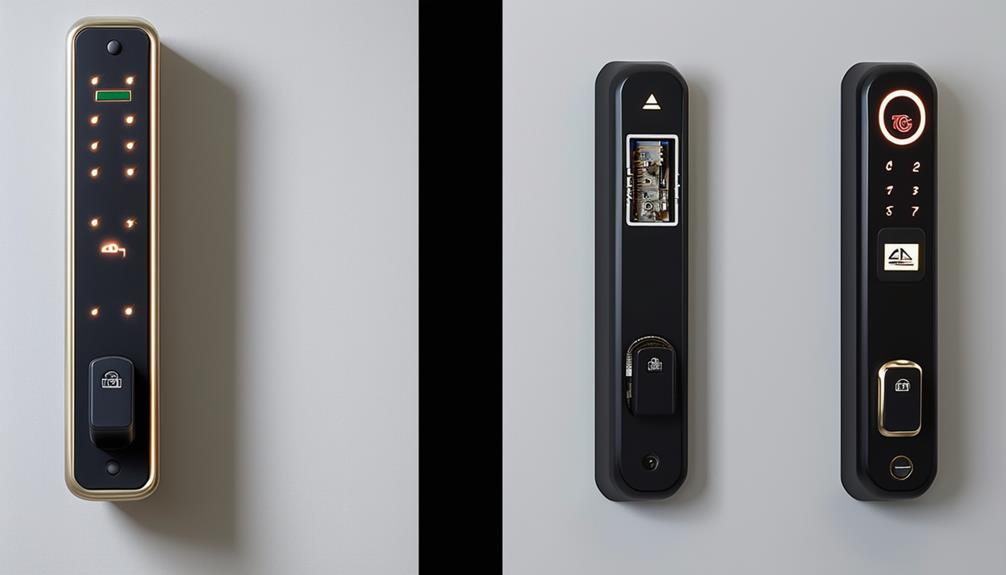
When evaluating the cost comparison between electronic and traditional panic bars, it's crucial to take into account both initial and long-term expenses. Electronic panic bar cost typically ranges from $1,000 to over $2,500, influenced by features like electric latch retraction and compatibility with access control systems. You can find professional and affordable installation services from Low Rate Locksmith, which guarantees your business meets all safety regulations quickly and efficiently. In contrast, traditional panic bars are more economical upfront, generally costing between $300 and $1,000.
However, the financial analysis doesn't stop at initial purchase. Consider the following:
- Maintenance Costs: Electronic panic bars incur higher maintenance costs due to regular checks of electrical components and battery systems. Traditional models require less complex upkeep.
- Installation Expenses: Electronic panic bars often necessitate professional installation due to their complexity, which can elevate initial costs. Traditional panic bars, being simpler, usually have lower installation expenses.
- Long-Term Savings: Despite higher initial and maintenance costs, electronic panic bars offer advanced functionalities such as remote access and automatic door connectivity. These features can reduce the need for additional security measures, potentially saving you money over time.
While the lifespan of electronic panic bars can be extended with proper maintenance, they may face obsolescence faster due to technological advancements. Traditional panic bars tend to have a longer service life, balancing out the initial cost disparity.
User Feedback on Electronic Panic Bars
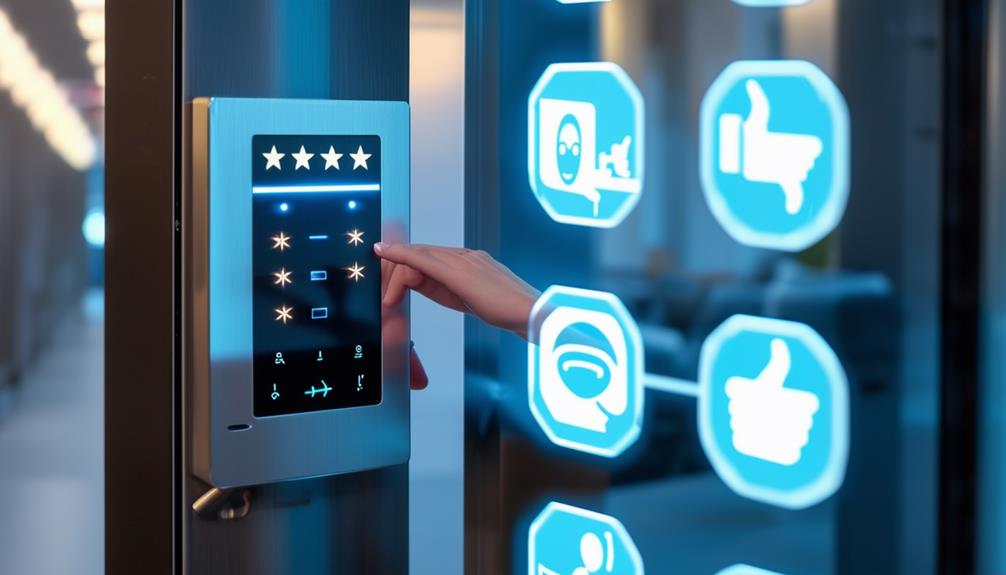
Over the past few years, user feedback on electronic panic bars has underscored their significant benefits in commercial settings. You'll find that these devices enhance security and accessibility, especially in high-traffic environments. Users often praise features like Electric Latch Retraction and Request-to-Exit functionality, which facilitate easy egress during emergencies. These features are essential for ensuring that occupants can swiftly and safely exit a building.
Moreover, many users appreciate the quiet operation of electronic panic bars, which minimizes disruption in busy settings, maintaining a peaceful environment. Integration with access control systems is another frequently highlighted advantage. This integration allows for remote locking and releasing, providing an added layer of security and convenience in managing entry points.
Compliance with fire and life safety regulations is a common point of positive feedback. Users are reassured knowing that electronic panic bars meet stringent safety standards, ensuring both legal compliance and enhanced safety for building occupants. Overall, the user feedback indicates that electronic panic bars are a robust solution for modern commercial settings, combining security, convenience, and regulatory compliance into a single, effective package.
Future Trends in Electronic Panic Bars
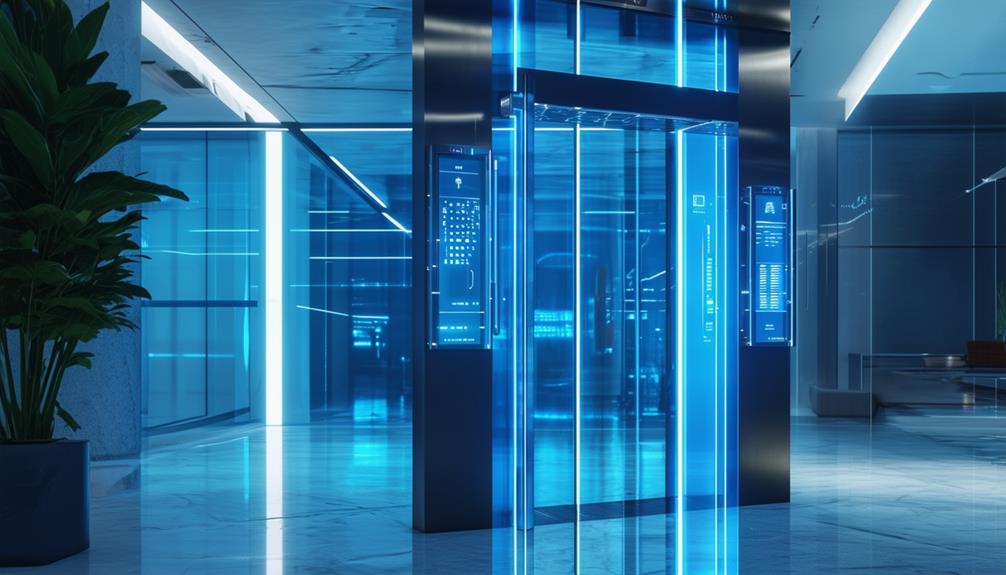
As the landscape of commercial security evolves, the future of electronic panic bars is set to be revolutionized by smart technology integration. You're looking at a world where panic bars with electronic monitoring will offer unprecedented security and efficiency. Imagine remote monitoring paired with mobile access control, giving you the power to oversee exit points from anywhere. Additionally, as highlighted in global usage trends, electronic panic bars are becoming more prevalent, reflecting their growing importance in safety standards worldwide.
Here are three compelling trends to watch:
- Biometric Authentication: Future designs will enhance user accessibility by incorporating fingerprint or facial recognition, making exits both quick and secure. No more fumbling with keys or codes; a simple scan will suffice.
- Energy Efficiency: Expect to see solar-powered panic bars, aligning with sustainable building practices. These energy-efficient mechanisms will reduce operational costs and contribute to a greener environment.
- IoT Connectivity: Enhanced connectivity with IoT systems will facilitate real-time alerts and notifications during emergencies. This guarantees faster response times and more effective safety management.
Moreover, modular designs will become commonplace, allowing for easy upgrades and customizations. This means your facilities can adapt to evolving security needs without the hassle of replacing entire systems. Stay ahead by embracing these future trends in electronic panic bars.
Advanced Security Solutions: Low Rate Locksmith's Electronic Panic Bar Services
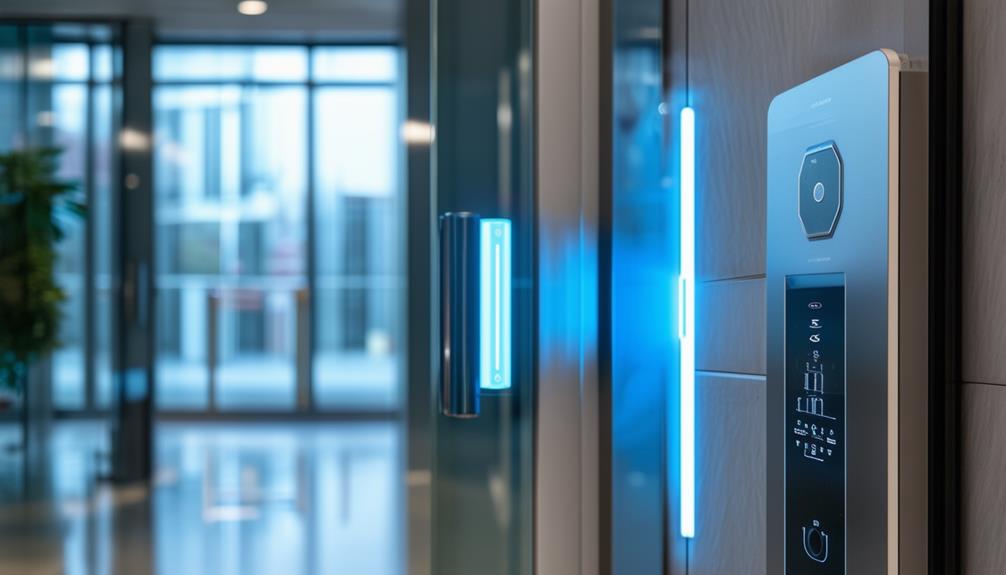
Enhancing security and accessibility for commercial buildings, Low Rate Locksmith's electronic panic bar services integrate seamlessly with your access control systems for remote release and automatic door connectivity. By leveraging electric panic bars, you facilitate quick exits through electric latch retraction, which complies with stringent fire and life safety regulations. Integrating panic bars with fire alarms further enhances safety by making sure doors automatically open during emergencies, facilitating faster evacuations.
Low Rate Locksmith offers models with both fail-safe and fail-secure features to suit your specific needs. Fail-safe options keep doors accessible during power outages, while fail-secure models maintain lockdown, guaranteeing security is never compromised. The request-to-exit functionality of these electric panic bars improves accessibility, making it easier for occupants to exit during emergencies without sacrificing security.
Perfect for high-traffic areas, these electronic panic bars are designed for reliable operation and durability, adhering to essential safety standards. The installation process is meticulous, assuring that every component aligns with your building's security infrastructure. Whether you're managing an office complex, school, or retail space, Low Rate Locksmith provides solutions that enhance both safety and operational efficiency.
Frequently Asked Questions
What Is the Function of Electric Panic Bars?
You'll find electric panic bars essential in providing remote access control, letting you open doors from afar for better security and convenience. They use Electric Latch Retraction (ELR) for quick exits by retracting the latch when the bar is pushed. With Request-to-Exit functionality, you'll comply with accessibility standards during emergencies. These bars integrate with existing access systems, ensuring security protocols while offering fail-safe or fail-secure options for power outage scenarios.
What Is the Difference Between a Panic Bar and a Crash Bar?
A panic bar is a door hardware designed for emergency exits, meeting stringent fire and safety regulations. It guarantees reliable function during emergencies, often including features like electric latch retraction. On the other hand, a crash bar is a generic term for any push bar mechanism, not always compliant with safety standards. Crash bars may lack the robust design and regulatory adherence required in high-occupancy commercial buildings.
What Are the Code Requirements for Panic Bar?
"Safety first" isn't just a saying; it's a mandate when it comes to panic bars. You need to guarantee compliance with NFPA 101 for easy egress, ADA for accessibility (placing bars 34-48 inches high), and UL 305 standards for safety and performance. Local building codes might also require fire-rated bars for specific occupancies. Remember, panic hardware must operate with a single motion—no tight grasping, twisting, or pinching allowed.
What Is the Difference Between a Panic Bar and a Push Pad?
A panic bar, when pushed, allows rapid egress and complies with fire safety codes, auto-locking upon closure. A push pad, conversely, requires a deliberate press to activate and may lack an auto-lock feature, making it more suited for high-traffic areas. Both integrate with electrified exit devices, but panic bars are specifically designed to meet stringent emergency egress standards, ensuring quick, efficient evacuation during crises.
Conclusion
While traditional panic bars offer reliability, electronic panic bars provide an unmatched blend of security and convenience. You're not just upgrading hardware; you're enhancing safety protocols. Brands like Low Rate Locksmith redefine industry standards with cutting-edge solutions. Installation is straightforward, but troubleshooting requires specialized knowledge. Although initially more expensive, electronic options prove cost-effective long-term. Users rave about the seamless integration. As technology advances, expect even more sophisticated electronic panic bars shaping the future of building security.

